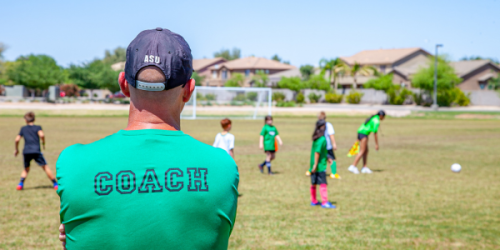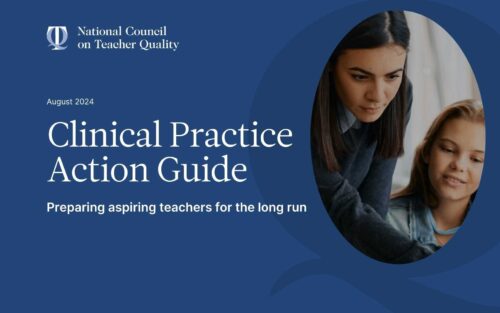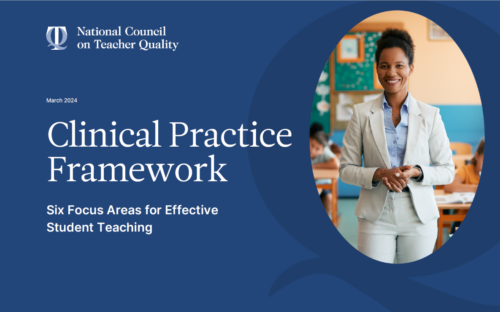In many states across the country it’s easier to become a teacher than a licensed driver. My sixteen-year-old son just recently got his driver’s permit. While requirements differ from state to state, the minimum in each state ensures that the driver completes 20 hours of supervised, behind-the-wheel daytime driving practice and 10 hours of supervised, behind the wheel nighttime driving practice—a total of 30 hours—before applying for a driver’s license. Most of us remember going into the DMV to take the driving test: a performance assessment where one shows that s/he meets specific driving competencies, including skills that require the driver to make judgment calls and take action in the moment.
Having these minimum requirements is important to the safety and well-being of ourselves and others who are on the road. Why would we not expect the same of those we charge with educating our nation’s youth? When it comes to preparing our teachers, who each impact the lives of dozens of children each day, our standards are inconsistent and in some cases much lower than the requirements to gain a driver’s license. Many states have seen an unprecedented surge in the number of new teachers who are prepared via alternative certification pathways (in Texas, 52% of its new teachers, almost 15% of the total annual production nationally). Often, these routes offer no classroom experience and little to no teacher preparation training before teachers lead a classroom of students.
Not only do these routes deprofessionalize the teaching profession, sending a message about what we prioritize for our children and what it takes to become an effective teacher, but they also set candidates up to perform poorly because they were poorly prepared. PK-12 students, ultimately, pay the price. While policies that allow for alternative certification options may have helped to address teacher quantity issues, they bring a steep cost for the quality of teacher we necessitate. Such policies slow and often prevent long-term, systemic, and sustainable growth for the profession. Not to mention, they adversely affect the communities that depend on effective classroom teachers the most.
In contrast, teacher preparation residencies, where candidates spend a full year student teaching under the guidance of a highly effective mentor teacher, provide extended time for future teachers to learn how to teach before they are responsible for their own classrooms. Research has found that residency pathways are some of the most effective ways to prepare new teachers who are diverse and well-prepared, but a full-year unpaid clinical experience is not accessible to many candidates. To address this, philanthropic organizations and federal grants have been used to support resident scholarships; however, these financial supports are difficult to sustain and only provide access to a small percentage of resident teacher candidates.
So how to address this divide between quality and cost? Educator preparation programs in University-School Partnership for the Renewing of Educator Preparation (US PREP) are in the process of scaling and sustaining residency pathways for all the candidates they prepare (over 20,000 new teachers each year). These programs haven’t allowed the challenges to become barriers. Instead, programs are working closely with their school district partners to design new ways to staff their schools by promoting teacher leaders and reallocating school vacancy dollars so that resident stipends become a part of how a school teacher pipeline is staffed.
One example is at the University of Texas Permian Basin and two partner districts: Ector County ISD and Midland ISD.In the 2020-21 school year teacher candidate residents are receiving sustainably funded stipends of $24,000 plus benefits, while completing a full-year residency under a highly effective mentor teacher. This structure meets immediate personnel needs of the school districts, ensures high-quality development of novice teacher candidates, and establishes a sustainable, scalable staffing model that positively impacts student achievement.
Building on the work in the Permian Basin, ten other colleges of education in US PREP are working together with their school district partners to redesign school staffing structures to include residents. This work is currently in the design stage and will officially launch with nearly 200 new paid residents in the Fall 2021 school year, with the goal of doubling each year thereafter. Texas Tech University has already extended this work to include paraprofessional pathways. Although data are not yet available, diversifying the teacher workforce is of highest priority.
US PREP and its coalition members are not the only ones who are thinking innovatively to scale and sustain residencies. Arizona State University’s Mary Lou Fulton Teachers College has been working to implement creative pathways into teaching through the Teacher Preparation and The Next Generation Workforce. School district partners reallocate teacher vacancy dollars to hire residents on teams with multiple professional educators.
Educator preparation programs, local education agencies (LEAs), and state agencies all have an important role to play in ensuring all teachers have access to the high-quality preparation they need to be ready on day one for students. Let’s make residencies “THE” pathway (Louisiana and Tennessee did it, and Delaware is on its way) and call on educator preparation programs and school partners to work closely to achieve solutions. When teacher preparation programs sustainably implement quality programming at scale, more new teachers will be better prepared to positively impact outcomes for Black, Latino, and economically disadvantaged students.
Dr. Sarah Beal is an NCTQ Senior Visiting Fellow and the Executive Director of the US PREP National Center. Prior to joining US PREP, Sarah served as an Executive Director for the largest Teacher Quality Partnership grant and Elementary Education Program Coordinator at Arizona State University’s Mary Lou Fulton Teachers College. Sarah also served as a classroom teacher and instructional coach for ten years in an urban school district in Phoenix, Arizona. Sarah holds a Doctor of Education degree in Leadership and Innovation and Master of Educational Mathematics degree from Arizona State University, and Bachelor of Liberal Arts degree from St. Mary’s College in Moraga, California.
More like this

Ahead of the pack: Which districts are setting strong clinical practice policies?




